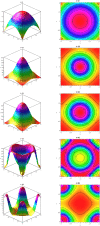The numerical solution of a mathematical model of the Covid-19 pandemic utilizing a meshless local discrete Galerkin method
- PMID: 36373015
- PMCID: PMC9638320
- DOI: 10.1007/s00366-022-01749-9
The numerical solution of a mathematical model of the Covid-19 pandemic utilizing a meshless local discrete Galerkin method
Abstract
It was in early December 2019 that the terrible news of the outbreak of new coronavirus disease (Covid-19) was reported by the world media, which appeared in Wuhan, China, and is rapidly spreading to other parts of China and several overseas countries. In the field of infectious diseases, modeling, evaluating, and predicting the rate of disease transmission are very important for epidemic prevention and control. Several preliminary mathematical models for Covid-19 are formulated by various international study groups. In this article, the SEIHR(D) compartmental model is proposed to study this epidemic and the factors affecting it, including vaccination. The proposed model can be used to compute the trajectory of the spread of the disease in different countries. Most importantly, it can be used to predict the impact of different inhibition strategies on the development of Covid-19. A computational approach is applied to solve the offered model utilizing the Galerkin method based on the moving least squares approximation constructed on a set of scattered points as a locally weighted least square polynomial fitting. As the method does not need any background meshes, its algorithm can be easily implemented on computers. Finally, illustrative examples clearly show the reliability and efficiency of the new technique and the obtained results are in good agreement with the known facts about the Covid-19 pandemic.
Keywords: Covid-19 pandemic; Galerkin method; Integral equation; Meshless method; Moving least squares; SEIHR(D)-compartment model.
© The Author(s), under exclusive licence to Springer-Verlag London Ltd., part of Springer Nature 2022, Springer Nature or its licensor (e.g. a society or other partner) holds exclusive rights to this article under a publishing agreement with the author(s) or other rightsholder(s); author self-archiving of the accepted manuscript version of this article is solely governed by the terms of such publishing agreement and applicable law.
Conflict of interest statement
Conflict of interestThe authors declare that they have no conflict of interest.
Figures

















Similar articles
-
Generalized moving least squares approximation for the solution of local and non-local models of cancer cell invasion of tissue under the effect of adhesion in one- and two-dimensional spaces.Comput Biol Med. 2020 Sep;124:103803. doi: 10.1016/j.compbiomed.2020.103803. Epub 2020 May 28. Comput Biol Med. 2020. PMID: 32738629
-
Numerical study of a nonlinear COVID-19 pandemic model by finite difference and meshless methods.Partial Differ Equ Appl Math. 2022 Dec;6:100460. doi: 10.1016/j.padiff.2022.100460. Epub 2022 Nov 4. Partial Differ Equ Appl Math. 2022. PMID: 36348759 Free PMC article.
-
Modeling and tracking Covid-19 cases using Big Data analytics on HPCC system platformm.J Big Data. 2021;8(1):33. doi: 10.1186/s40537-021-00423-z. Epub 2021 Feb 15. J Big Data. 2021. PMID: 33614394 Free PMC article.
-
Usage of Compartmental Models in Predicting COVID-19 Outbreaks.AAPS J. 2022 Sep 2;24(5):98. doi: 10.1208/s12248-022-00743-9. AAPS J. 2022. PMID: 36056223 Free PMC article. Review.
-
An Overview of the World Current and Future Assessment of Novel COVID-19 Trajectory, Impact, and Potential Preventive Strategies at Healthcare Settings.Int J Environ Res Public Health. 2020 Sep 25;17(19):7016. doi: 10.3390/ijerph17197016. Int J Environ Res Public Health. 2020. PMID: 32992809 Free PMC article. Review.
References
-
- Arqub OA, Maayah B. Numerical algorithm for solving time-fractional partial integrodifferential equations subject to initial and Dirichlet boundary conditions. Numer Methods Partial Differ Equ. 2018;34:1577–1597. doi: 10.1002/num.22209. - DOI
-
- Arqub OA, Al-Smadi M, Shawagfeh N. Solving Fredholm integro-differential equations using reproducing kernel Hilbert space method. Appl Math Comput. 2013;219(17):8938–8948.
-
- Assari P, Dehghan M. A meshless method for the numerical solution of nonlinear weakly singular integral equations using radial basis functions. Eur Phys J Plus. 2017;132:1–23. doi: 10.1140/epjp/i2017-11467-y. - DOI
-
- Assari P, Dehghan M. Solving a class of nonlinear boundary integral equations based on the meshless local discrete Galerkin (MLDG) method. Appl Numer Math. 2018;123:137–158. doi: 10.1016/j.apnum.2017.09.002. - DOI
-
- Assari P, Dehghan M. The numerical solution of two-dimensional logarithmic integral equations on normal domains using radial basis functions with polynomial precision. Eng Comput. 2017;33(4):853–870. doi: 10.1007/s00366-017-0502-5. - DOI
LinkOut - more resources
Full Text Sources
Research Materials
